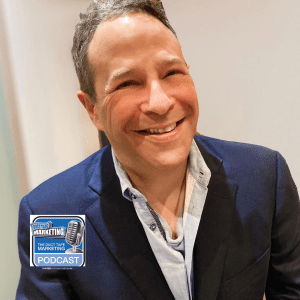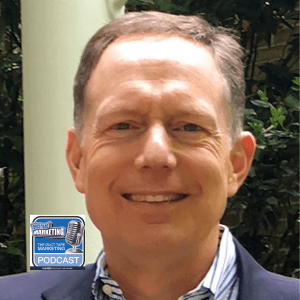Why Being Human Is Your Brand’s Biggest Asset
Why Being Human Is Your Brand’s Biggest Asset written by John Jantsch read more at Duct Tape Marketing
Marketing Podcast with Jacqueline Lieberman
 In this Duct Tape Marketing Podcast episode, I interview Jacqueline Lieberman. Jacqueline is the former Managing Partner and the Head of Strategy Story Worldwide and current founder of BrandCrudo.
In this Duct Tape Marketing Podcast episode, I interview Jacqueline Lieberman. Jacqueline is the former Managing Partner and the Head of Strategy Story Worldwide and current founder of BrandCrudo.
![]()
![]()
Key Takeaway:
Brands are people’s introduction to businesses and their way to interact with companies. The more human a brand is, the better that interaction is going to be. All of the beloved brands that are out there are the ones that behave like human beings. They have a conscience, a point of view, a soul, and a personality. In this episode, Jacqueline Lieberman discusses the work that she does with her clients and the ways in which she has helped many brands become more human.
Questions I ask Jacqueline Lieberman:
- [1:04] One of the things you’re talking about often is making brands more human and putting purpose into practice – can you talk about taking it beyond the tagline?
- [3:54] Some companies brand themselves in a way that has nothing to do with their product – like insurance companies for example. Is creating a brand personality an effective approach?
- [5:36] How do brands address the fact that there are so many channels to reach consumers that are in a lot of ways are out of their full control?
- [8:26] What’s generally going on when a business calls in an outside brand strategist, what’s your process, and then what do you do to try to turn the ship?
- [12:28] What role does internal politics play in bigger companies when it comes to branding?
- [13:42] How often do you get the chance to go deeper than marketing?
- [14:58] Do you have any examples where typical gaps happen and there’s no internal communication that is creating a bad experience?
- [19:26] 2021 is still going to be a year where people are reeling from 2020. Is there a message of trends, behaviors, or things that people need to be aware of?
More About Jacqueline Lieberman:
- Learn more about Jacqueline’s company: BrandCrudo
- Jacqueline’s podcast: Uncooked
More About The Certification Intensive Training:
- Learn more about the training
This episode of the Duct Tape Marketing Podcast is brought to you by the HubSpot Podcast Network.
Like this show? Click on over and give us a review on iTunes, please!
John Jantsch (00:01): This episode of the Duct Tape Marketing Podcast is brought to you by Outbound Squad, formerly Blissful Prospecting, hosted by Jason Bay. It’s brought to you by the HubSpot Podcast Network, the audio destination for business professionals. Jason Bay is a leading sales expert and he talks with other leading sales experts to get you the information you need. I’ve recent episode, he talked about how much time you need to spend prospecting. Really, really eye-opening. Check it out. Uh, listen to the outbound squad, wherever you get your podcasts.
(00:43): Hello
(00:44): And welcome to another episode of the Duct Tape Marketing Podcast. This is John Jantsch and my guest today is Jacqueline Lieberman. She’s a former managing partner and the head of strategy for Story Worldwide and the Curve founder of Brand Crudo. So I guess we’re gonna talk about brands today. So Jacqueline, thanks for joining me.
Jacqueline Lieberman (01:03): Thanks for having me, John. It’s
John Jantsch (01:05): Pleasure. So I I, I always like to get kind of to deeper than the tagline, shall we say
Jacqueline Lieberman (01:22): Oh, sure. Well, I mean, I think one of the things, one of my goals is really when I say I wanna make brands more human, is when I think about brands, brands are really people’s introduction and their way to interact with companies. Mm-hmm.
John Jantsch (01:58): But they’re also probably telltale signs. They’re also able to communicate that effectively and deliver on it effectively. And, and people experience that. It’s not enough to just have that soul, is it?
Jacqueline Lieberman (02:08): Exactly.
John Jantsch (02:18): So I work, I work with a lot of small business owners and have over the years, and if I mention the, the, you know, I sometimes call it the B word because they’re, they’re almost like, oh, well I don’t have a brand that’s, that’s for big product companies. And my contention is every business has a brand because it’s, it’s really just the collective perception of the people that you come into contact with. Good, bad, or indifferent. So, so where do you fall on, you know, companies kind of ignoring that idea?
Jacqueline Lieberman (02:44): Well, I mean, I think even, even those owners, their brands, their personal brands walking around embodying. So, so even if it’s their company, and just because they might have a a business name doesn’t mean that they’re not a brand cuz they’re associated with when they, when somebody hears the name of that company, somebody is going to have a gut feeling about that, that company. And so whether it’s the, the person’s, the founder’s name on the wall, or it happens to be a, a name that you just made up that has to resonate with people. And so you have to really pay attention to that and have some care and attention into branding even if you’re
John Jantsch (03:24): Small. So, so I wanna get into some specifics, but I will tell you this time of year, a lot of people are watching, uh, football, I dunno if you’re a N f NFL fan at all, but, uh, playoff season, a lot of people are, and, and of course all the ads are insurance companies that are basically communicating a brand that has nothing to do with their product. A progressive Geico, even State Farm, it seems, it seems to be the trend with insurance companies is, is create personality. So we don’t have to talk about products people don’t really wanna buy anyway,
Jacqueline Lieberman (04:03): Well, I mean, I think, so taking insurance just for an example, I mean, so that’s, that’s a tough, that’s a tough market to be in, right? Right. So talk about like a low interest category. We’re not talking about automobiles that people look forward to having that purchase when the, when the time comes. So, so taking that tact is, is smart for insurance because they have to associate their brand with something that’s positive because for insurance, the flip side of insurance is that you don’t wanna need it. So the flip side is that there’s some sort of disaster that has happened to you. So they wanna make it a positive feeling. And I think that that’s exactly why all of those brands are taking the tack that they are. But that said, I think that that’s a lesson a lot of brands can, can take. And it doesn’t matter a lot of, as you mentioned before, oh, I’m a small business and I’m not a big brand, but I think it doesn’t matter what category you’re in, you can still create a brand around what you’re doing because that has to resonate with people, and that’s the only way that you’re going to be able to connect with people is, is by doing that.
John Jantsch (05:09): Well. And I think particularly today, there’s so many channels and ways to reach, uh, consumers that I think a lot of that’s happened. I, I I think brands in a lot of cases, what going back 20, 30, 40 years ago, I know you weren’t around, but it, it, but for some of my listeners, the brand was kind of the personality of your advertising in a lot of ways was, was the brand. But now you go on, you look at Google reviews and they talk about Rusty, the technician that came to their house and did an amazing job, and all of a sudden that’s the brand. So how, how do, how do you suggest that brands, I I wanna say deal, that’s probably the wrong word, address the fact that there are so many channels and, and so much of the, the brand in a lot of ways is, is certainly out of our control.
Jacqueline Lieberman (05:51): Yeah. And, and I think, well, I mean, I know that Marty Newmeyer famous author of the Brand Brand Gap, he, he basically says, A brand is not what you say it is, right? It’s what, what everybody else says it is. And so that’s really, that’s really what a brand is. So in looking at those reviews, and that’s the best social listening that a brand can do, by the way, is, uh, that’s the best consumer insight. But I think when looking at brands, I usually, the, the quickest, one of the quick tools that I always give to, uh, any client, and even on social me, my social media feeds, is saying, if you think about a brand in terms of three spheres of like, you think of a Venn diagram of you have mind, you have heart, you have conscience, and it’s thinking about a brand is like in their mind, what’s their point of view in the conscience?
(06:41): What’s the soul? How do you wanna be remembered? And the heart is what are your non-negotiable beliefs? So in saying those things and, and when you’re talking about and how to deal with reviews, it’s the reviews fit under one of those things, right? Yeah. So, so it’s like, and how a brand should respond is really about that. So if you’re always thinking in the realm of that you have kind of those three facets of the brand, it really dimensionalizes it and it gives you latitude to dial things up or down as you need to. So you could still be agile and respond. So it doesn’t have to be just, here’s the advertising line. It’s like, well, no, what’s our point of view about this? Or No, but how do we help these people who are having the same problem in these reviews? And so I think it’s just like an easy construct that people can really wrap their heads around, even if they know nothing about branding or marketing, I just kind of give that to them as a, as a framework. And it starts to lead people, even non marketers down to a place of like, Hmm, how, how do I think about my brand as a conscience? Yeah. And so
John Jantsch (07:44): Yeah. So as you start getting into like, what would the brand do cluster, right?
Jacqueline Lieberman (07:53): Exactly.
John Jantsch (07:54): Say that. So, so when somebody calls you in, and I know that you, I I, I know that it’s very common for, uh, brands to have a marketing agency that is really doing a lot of the tactics, a lot of the execution, and they will typically sometimes call in a, an outside or a third party brand, uh, strategist. What’s generally going, uh, this is about a five-part question. What’s generally going on when that happens? And then what’s your process then for adding or, or I think you used the word excavating as a, as a as part of the process. So, so walk me through what’s going on when somebody finally does that, and then what do you do to try to turn the ship?
Jacqueline Lieberman (08:33): Yeah. Well, I mean, a lot of times, so unfortunately what happens is, and I don’t know why, maybe you can tell me why in your opinion, I’d love to hear what you think about it is, I don’t know why, but there’s, when management, there seems to be a, a change in management Yeah. And it doesn’t matter, uh, really what the level is, but it’s typically at the senior level, they feel like that they need to completely blow up the brand Yeah. And start over and put their own point of view and their spin on it for the sake of doing something new and relevant. And I’m not saying that, that being new and relevant and, and having a new marketing point of view is, is the wrong way to go. Because usually if there’s a change in leadership, there’s a need for that change. Yeah.
(09:22): Yeah. But the, the part that I, that I always find so surprising is that they come in with no regard to the history of the brand, the origin story of the brand. So whether that origin was five years ago or 50 years ago, or a hundred years ago, it doesn’t matter. Every brand started for some reason. It was some, somebody thought of it for a reason, there was a value there. So typically what happens is I’ve gotten called in now more, more than I can count for that scenario where there’s a change of a change. Of course, the rest of the team doesn’t agree. The senior management wants to go in one direction, but then there’s legacy people who feel like that they’re go, that it’s in their gut, that it doesn’t feel right. Yeah. And they need somebody, they need like a, an a third party to come in to just kind of almost do brand therapy.
(10:14): Yeah. To understand. So, so the excavate the excavating part is me talking to the C e O or the CMO and finding out, so tell me exactly why is it that you think that this part of the brand needs to change? And very often those are the conversations. That’s when I start pulling out really the reasons why, because the reasons that they’re articulating is actually not it at all. Yeah. Yeah. And so when I start going in and asking those questions, well, tell me why, and tell me a little bit more about that. And then I also will interview the, the other stakeholders, the people who perhaps have been on board for a while. And I start to kind of marry those two worlds together. And, and that’s really the beginning of the new brand foundation. So it doesn’t mean that we’re forgetting the origin story, and it doesn’t mean that all we’re talking about is legacy stuff. It just means that we’re creating a new foundation, starting from a fresh place that has everybody’s input at the table. Does that make sense?
John Jantsch (11:13): Are you an agency owner, consultant or coach that works with business owners? Then I want to talk to you about adding a new revenue stream to your business that will completely change how you work with clients. For the first time ever, you can license and use the Duct Tape Marketing system and methodology in your business through an upcoming three day virtual workshop. Give us three days and you’ll walk away with a complete system that changes how you think about your agency’s growth. The Duct Tape Marketing System is a turnkey set of processes for installing a marketing system that starts with strategy and moves to long-term retainer implementation engagements. We’ve developed a system by, by successfully working with thousands of businesses, now you can bring it to your agency and benefit from all the tools, templates, systems and processes we’ve developed to find out when our next workshop is being held, visit dtm.world/workshop. That’s dtm.world/workshop.
John Jantsch (12:14): Yeah, absolutely. But I, but you could see the, you could see the pressure, the internal pressure, the CMO just got fired. The new CMO is not going to make any headway by saying, we’re just going to keep going down this path. Right. So Exactly. They do have to bring in kind of their ownership. C this is sort of a weird question, but since we’re talking about bigger companies, what role does politics internally play in, in the mess that gets made?
Jacqueline Lieberman (12:38): Yeah. A lot. Uh, it’s a huge role and I think, and a lot of, a lot of my role I end up playing is I am the facilitator and I’m bringing all of these worlds together in a way that allows them to all speak their mind Right. In a safe place. And, and I’m the one, so if I’m the one that’s coming up with the insights and playing back what I heard, then there isn’t there, there are no enemies made because they can’t argue really with me because it’s like, well, I’m saying, well, this is what I heard. Yeah. And so that’s, so I become like the facilitator, the therapist, the marriage counselor, bringing everybody together. But at the same point, I’m also constantly asking questions to mind. Well, why? And tell me more about that. And when you say your values are, you’re a trusted brand, by the way, everybody says they’re a trusted brand, but tell me exactly why you think that. So, so that’s really a lot of what my role is, is to help get away from those politics and just kind of ask the right questions.
John Jantsch (13:42): How often do you get the chance to go deeper than marketing? So into sales, into service, you know, into, you know, pretty much every facet because I, that’s all part of the brand, whether people, people say it or not. So how, how often do you get that opportunity?
Jacqueline Lieberman (13:59): Well, when I do workshops, I specifically ask for the attendees in the workshops to be all representatives from, and I ask for, give me somebody from sales, give me somebody from r and d, somebody who sits in customer service. I don’t want of all marketing people in that room. Right. So I say, if we have to make this a, a two-part process, then let’s do it. But I do not wanna have all marketing people in the room because, because to your point, a brand is made up of all different facets. It’s not just what the marketing team dreams up. So I need to understand the points of view. And very often a lot of that insight comes from the people, not in the marketing department. It comes from the people on the front lines or the people who are thinking about the brand in different ways.
John Jantsch (14:42): Yeah. Re referrals rarely happen because of good marketing
Jacqueline Lieberman (14:46):
John Jantsch (14:47): Right. And, and, and yet most businesses, a significant part of their business comes by way of referral. And that happens because somebody had a great experience. Yeah.
Jacqueline Lieberman (15:16): Yeah. Well, I mean, there’s, there’s one where there’s a, a human legacy founder person mm-hmm.
(16:16): So really the recall is really how people start to embody it in their everyday life. So if you can’t remember what your mission is, then it’s like, then it’s probably too long and wordy. Right. And you probably need to revisit it. But the other part of it is taking that purpose into practice. And, and that really is going right down to, at the HR level of like, you need to put your purpose in your job postings, make sure you’re hiring the right culture. You need to put it in your performance reviews that everybody needs to be accountable for living the purpose and embodying it in your everyday jobs. Because if, if, if you don’t bring it down to that level, then it really is just a nice statement in the lobby.
John Jantsch (17:00): Yeah. It’s interesting. I think they’re growing consensus among, uh, organizations that internal communications is actually where branding maybe starts.
Jacqueline Lieberman (17:08): Yes.
John Jantsch (17:09): Completely. So, so talk to me a little bit about whether what you’ve seen or maybe how you sort of advise people on that.
Jacqueline Lieberman (17:17): Yeah, I mean, I think it’s, it really because, I mean, I think it’s the, it’s how people think about marketing. So people just think that marketing is this advertising box that you need to check in order to sell stuff, but at the same point, it’s really having a group of evangelists who believe in it inside. Mm-hmm.
John Jantsch (18:18): Well, and it’s, it’s, it’s painful almost to see these companies that transparency is one of our core values, and then internally, there’s no transparency,
Jacqueline Lieberman (18:37): Yeah, exactly. I mean, when, when it’s very, I mean, and I, I could see why it happens because businesses, they’re myopically focused on the task at hand right in front of them. And they’re trying to just get through what they need to get through. Especially right now, everybody is, you know, having a hard time in, in all different ways. But, but you have to at least be in the regular practice of going 30,000 feet once in a while, once a quarter, once a year at least. And start to look at your brand from that level and say, how are we really living our purpose? Is it really trickling down? Is it something that we need to reevaluate? How are we creating this world for the consumer? That’s something that they wanna be in as opposed to us just selling messages.
John Jantsch (19:26): 2021 is still gonna be a year where I think people are reeling from 2020. And so is there a, is there a message of trends or behaviors or things that people need to be aware of or looking out for or doing more of or doing less of? Or is it still, i, is it really just a matter of, of be true and stay the course?
Jacqueline Lieberman (19:50): Well, I mean, well, it’s definitely be true and stay of the course. I mean, for sure, what the pandemic has highlighted is it really highlighted the brands who did not, if they were not already purpose driven, it really highlighted the brands who were struggling with that. So it’s like, if you already know that and that’s already part of your marketing, then it’s, you’re ahead of the game. And the reason why is because consumers are really out there and they’re looking for, they’re looking for something like, they’re looking for a little glimmer of hope and optimism. And that’s what brands and companies give each other. And so if you’re just giving pla platitudes and you’re not really doing anything of substance, then consumers are really gonna look at that, and they’re making their choices because of that. And, and I think the brands who are winning right now are the ones that are, are really doing things that are, that are real. And not just marketing because they’re trying, trying to just hang on and survive.
John Jantsch (20:49): Yeah. They’re, they’re, they’re meaningful in some way to their customers. That is a good way to, good way to look at it. So you have a podcast as well, uh, called Uncooked. Do you wanna tell people what they could expect if they tuned in?
Jacqueline Lieberman (21:01): Sure. Um, so I’ve been told that it’s, uh, npr like in terms of, in terms of the format, and I, I like to have guests on who either have a great brand story to tell. So if it’s a new up and coming brand or even a legacy brand, I like to have brands on who have an authentic story and beginning that they wanna share. And I try to dissect that in a way that I extract insights that really, if you are a planner, if you’re a creative, a designer, uh, account person, if you’re listening to it, you can apply those insights directly to your work. And that’s really what I’m trying to do is, is give people kind of like a marketing insights one-on-one that if you need, if you have 20 minutes from your day and you wanna listen, but you can listen to that and extract and apply to your work.
John Jantsch (21:47): Awesome. So you wanna tell people where, uh, they can find out more about, uh, brand crude and, uh, your work? Sure,
Jacqueline Lieberman (21:54): Yeah. Uh, so you can go to, uh, dub dub dub brand crude.com and on, there’s a link to uncooked. We’re on Apple Spotify anywhere you, you know, get to podcast. But, but yeah, you can find everything there on brand crude.com.
John Jantsch (22:08): Awesome. Well, Jacqueline, uh, it’s a pleasure spending time with you this afternoon and hopefully, uh, we can run into each other when we’re back out there on the road someday.
Jacqueline Lieberman (22:16): Wouldn’t that be nice,
John Jantsch (22:20): Hey, and one final thing before you go. You know how I talk about marketing strategy, strategy before tactics? Well, sometimes it can be hard to understand where you stand in that, what needs to be done with regard to creating a marketing strategy. So we created a free tool for you. It’s called the Marketing Strategy Assessment. You can find it @ marketingassessment.co, Check out our free marketing assessment and learn where you are with your strategy today. That’s just marketingassessment.co. I’d love to chat with you about the results that you get.
Sign up to receive email updates
Enter your name and email address below and I’ll send you periodic updates about the podcast.
This episode of the Duct Tape Marketing Podcast is brought to you by the HubSpot Podcast Network.

HubSpot Podcast Network is the audio destination for business professionals who seek the best education and inspiration on how to grow a business.
Did you miss our previous article…
https://www.sydneysocialmediaservices.com/?p=4263









